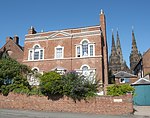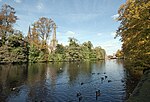Lichfield Clock Tower

Lichfield Clock Tower or Friary Clock Tower is a 19th-century Grade II listed clock tower located on 'The Friary' south of Festival Gardens in the city of Lichfield, Staffordshire in the United Kingdom. The tower was erected in 1863 at the junction of Bird Street and Bore Street over the site of the ancient Crucifix Conduit which supplied water to the Friary since 1301. In the early 20th century, since the invention of the motor car, Bird Street and Bore Street were becoming congested with traffic due to their narrow layout and the position of the clock tower only made matters worse. In 1928 the road named ‘The Friary’ was built across the former Friary site. The building of this road necessitated the relocation of the clock tower, 400m west of its original location along the new road.
Excerpt from the Wikipedia article Lichfield Clock Tower (License: CC BY-SA 3.0, Authors, Images).Lichfield Clock Tower
The Friary, Lichfield Darwin Park
Geographical coordinates (GPS) Address External links Nearby Places Show on map
Geographical coordinates (GPS)
| Latitude | Longitude |
|---|---|
| N 52.679691 ° | E -1.833418 ° |
Address
Clock Tower
The Friary
WS13 6QJ Lichfield, Darwin Park
England, United Kingdom
Open on Google Maps








